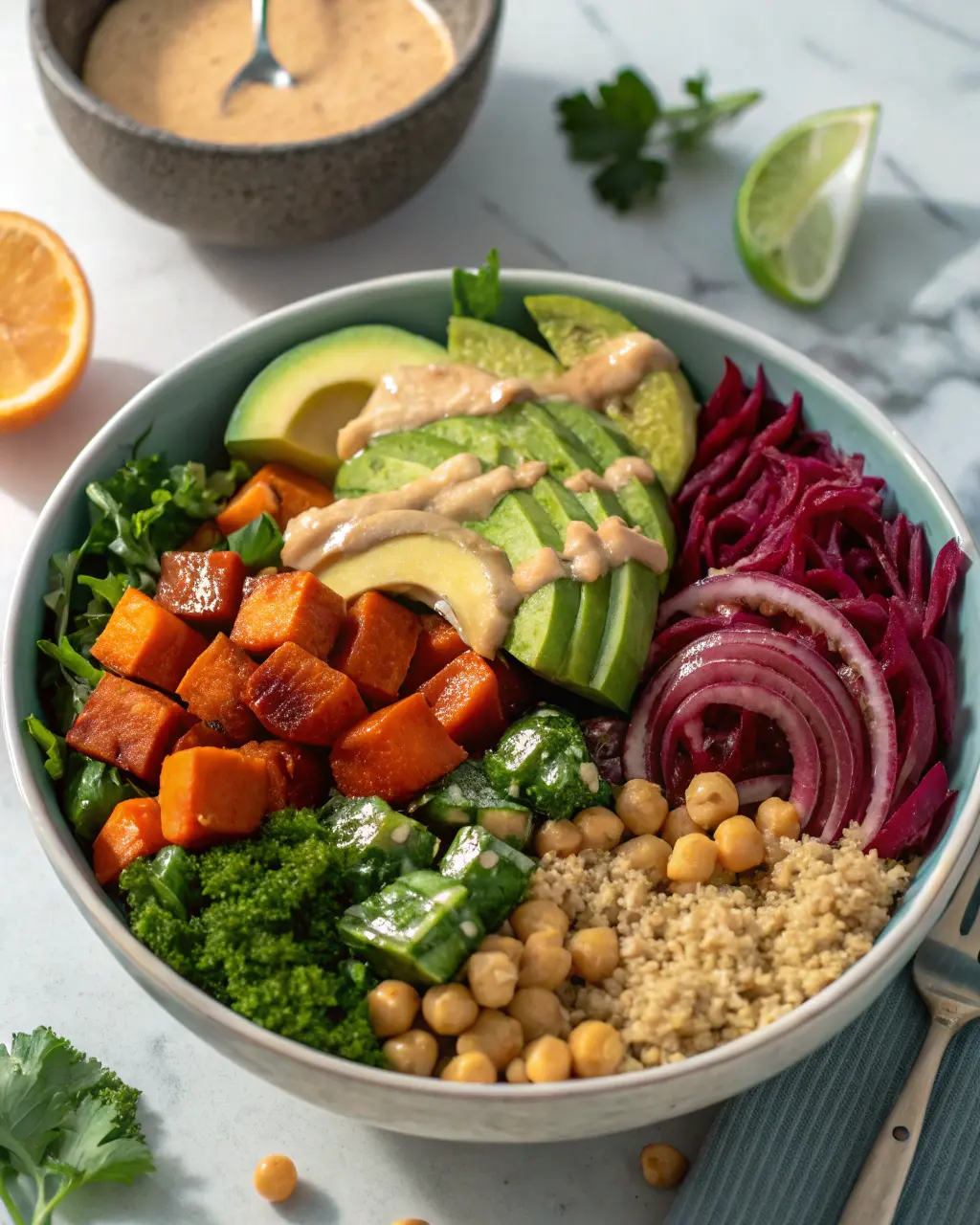Introduction
A Colorful Buddha Bowl is more than just a meal; it’s a vibrant tapestry of flavors, textures, and nutrients artfully arranged in a single bowl. Imagine a stunning composition featuring wholesome grains, plant-powered proteins, an abundance of fresh and roasted vegetables, drizzled with a delicious dressing – that’s the essence of this increasingly popular dish. It’s a feast for the eyes before it even delights the palate, embodying a philosophy of mindful eating and balanced nutrition. Whether you’re a seasoned foodie or just beginning your journey into healthier eating habits, the customizable nature of the Colorful Buddha Bowl makes it an exciting and accessible option for everyone seeking a satisfying and visually appealing meal. Explore more lunch ideas on our site!
Table of Contents
What Exactly is a Colorful Buddha Bowl?
While the term “Buddha Bowl” might conjure images of ancient traditions, its modern interpretation is a versatile and nourishing one-bowl meal. It’s not tied to a specific cuisine but rather a flexible formula that emphasizes balance, variety, and whole foods. Think of it as a personalized canvas for healthy eating, where different components come together harmoniously.
Beyond the Basics: Defining the Concept
At its core, a Colorful Buddha Bowl is typically a vegetarian or vegan meal served in a large bowl, characterized by small portions of several different foods arranged artfully. It usually includes a base of grains or greens, various vegetables (raw, roasted, or steamed), a protein source (like tofu, beans, lentils, or sometimes fish/chicken for non-vegetarian versions), and a flavorful dressing. The emphasis is on combining diverse textures, colors, and nutritional elements to create a complete and satisfying dish that doesn’t rely on complex cooking techniques but rather on thoughtful assembly.
The Philosophy: Mindful Eating in a Bowl
The name itself, while debated (more on that later), often evokes a sense of mindfulness and balance, reflecting the rounded shape of the bowl resembling a Buddha’s belly, symbolizing abundance and contentment. Eating a Colorful Buddha Bowl encourages a more conscious approach to food. The act of arranging the different components invites appreciation for the ingredients, their colors, and textures. It promotes portion control naturally and encourages the consumption of a wide array of plant-based foods, aligning with principles of mindful eating – paying attention to your food and savoring the experience, fostering a healthier relationship with what you consume.
The Vibrant Appeal: Why Choose a Colorful Buddha Bowl ?
The allure of a Colorful Buddha Bowl extends far beyond its trendy status. It represents a fundamentally appealing way to approach meals, combining significant nutritional advantages with undeniable aesthetic charm. Choosing this type of bowl is choosing a path towards more vibrant and enjoyable healthy eating.
Eating the Rainbow: A Nutritional Powerhouse
Health experts often advise us to “eat the rainbow,” and a Colorful Buddha Bowl is the perfect embodiment of this principle. Each color in fruits and vegetables typically signifies the presence of different phytonutrients, vitamins, and minerals, all essential for optimal health. Bright reds might indicate lycopene, deep greens are rich in chlorophyll and folate, vibrant oranges and yellows offer beta-carotene, and purples contain anthocyanins.
By intentionally incorporating a wide spectrum of colorful ingredients – think beets, carrots, spinach, bell peppers, purple cabbage, sweet potatoes – you naturally create a meal packed with diverse antioxidants and nutrients that support everything from immune function to chronic disease prevention, as highlighted by health resources like Integris Health.
A Visual Feast: Making Healthy Food Irresistibly Exciting
Let’s face it: we eat with our eyes first. A drab, monochromatic plate can feel uninspiring, even if it’s healthy. A Colorful Buddha Bowl, however, is inherently exciting. The deliberate arrangement of contrasting colors and textures transforms a simple meal into a work of art. This visual appeal can significantly enhance the dining experience, making healthy food more desirable and enjoyable. It encourages creativity in the kitchen and can even be a fun way to get kids interested in eating more vegetables. When healthy food looks this good, sticking to nutritious choices becomes less of a chore and more of a pleasure.
Deconstructing the Perfect Bowl: The 5 Key Components
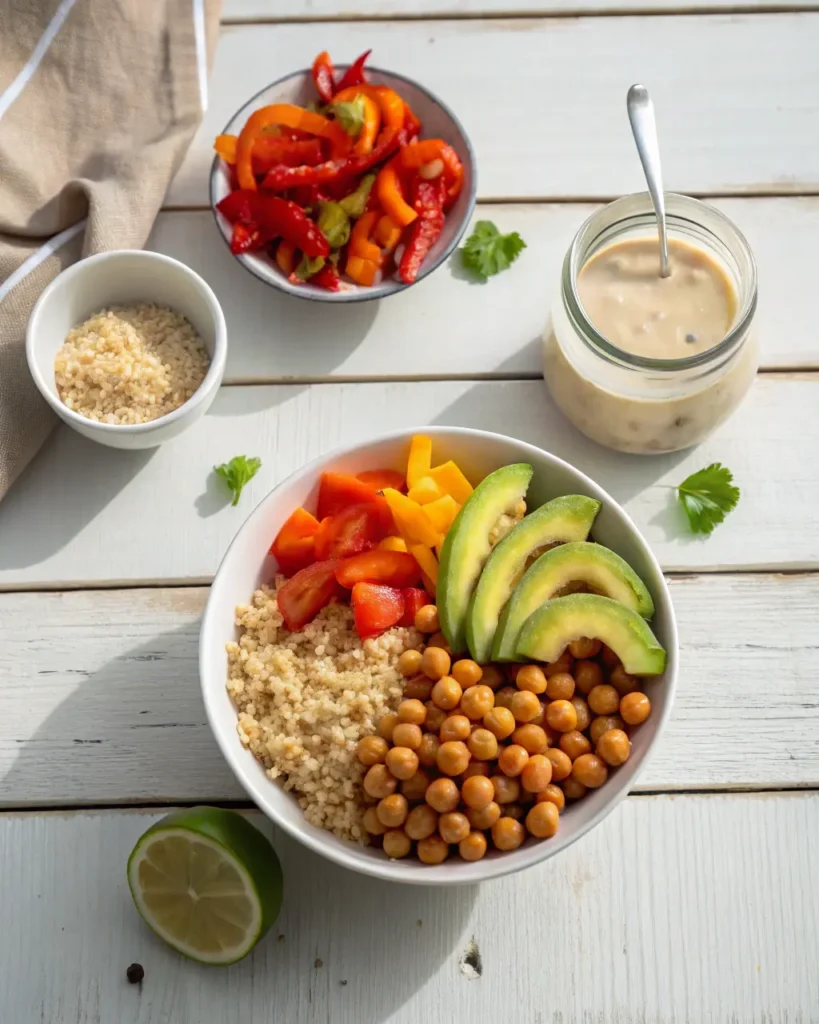
Building a truly satisfying and nutritionally balanced Colorful Buddha Bowl isn’t about rigid rules, but understanding the core elements ensures a delicious and wholesome result every time. So, what are the 5 key components of a Buddha bowl? Think of it as a flexible formula with five essential building blocks that work together to create harmony in your bowl.
The Foundation: Wholesome Grains or Leafy Greens for Your Colorful Buddha Bowl
Every great bowl starts with a solid base. This typically consists of whole grains like quinoa, brown rice, farro, or millet, which provide complex carbohydrates for sustained energy and essential fiber. Alternatively, for a lighter option or a different texture profile, you can use a bed of leafy greens such as spinach, kale, arugula, or mixed lettuces. Sometimes, a combination of both grains and greens works beautifully, offering the best of both worlds.
Plant-Powered (or other) Protein: Fueling Your Body Sustainably
Protein is crucial for satiety and muscle maintenance. Traditional Buddha bowls lean heavily on plant-based proteins. Excellent choices include crispy baked tofu or tempeh, roasted chickpeas, lentils, edamame, black beans, or kidney beans. For those who aren’t strictly vegetarian or vegan, grilled chicken, salmon, or hard-boiled eggs can also be incorporated, though the spirit often emphasizes plant sources. For more ideas on incorporating protein effectively, check out these high protein lunch recipes. The key is choosing a protein that complements the other flavors in your Colorful Buddha Bowl.
Veggie Overload: Maximizing Colors, Textures, and Nutrients
This is where the “colorful” aspect truly shines! Load up your bowl with a diverse array of vegetables. Aim for a mix of raw and cooked options to vary the textures and nutrient availability. Think roasted sweet potatoes or broccoli, steamed carrots or green beans, raw bell peppers, cucumbers, shredded beets, or cherry tomatoes. Don’t shy away from variety – the more colors you include, the wider the range of vitamins, minerals, and antioxidants you’ll consume. This component is fundamental to making your bowl a nutritional powerhouse.
Healthy Fats & Flavor Boosters: Dressings, Sauces, and Avocado
No Colorful Buddha Bowl is complete without a delicious dressing or sauce to tie all the elements together. Healthy fats are also essential for nutrient absorption and overall satisfaction. Creamy avocado slices or guacamole are popular additions. Dressings can range from simple lemon-tahini or vinaigrette to more complex peanut sauces or creamy cashew dressings. Choose dressings based on healthy oils, nuts, seeds, or yogurt, avoiding overly sugary or processed options. This component adds moisture, richness, and a significant flavor dimension.
The Finishing Touch: Seeds, Nuts, Herbs, and Crispy Bits
Finally, elevate your creation with toppings that add texture, extra nutrients, and a final flavor pop. Sprinkle on pumpkin seeds, sunflower seeds, chia seeds, or hemp hearts for crunch and healthy fats. Chopped nuts like almonds or walnuts add richness. Fresh herbs such as cilantro, parsley, or mint bring brightness. You might also consider adding fermented foods like sauerkraut or kimchi for gut health benefits, or crispy elements like toasted nori strips or baked wonton crisps for added textural contrast. These finishing touches make your bowl truly special.
Are Buddha Bowls Healthy for Weight Loss? Exploring the Facts
Many people turn to options like the Colorful Buddha Bowl when aiming for weight loss, drawn by their reputation for being healthy. But are Buddha bowls inherently good for shedding pounds? The answer lies in how they are constructed and consumed, focusing on nutrient density over mere calorie counting.
Calorie Consciousness vs. Nutrient Density in Your Bowl
While a Colorful Buddha Bowl can be low in calories, it’s not automatically guaranteed. The final calorie count depends heavily on the specific ingredients chosen and, crucially, the portion sizes. A bowl loaded with high-calorie dressings, excessive grains, or large amounts of nuts and seeds can easily become calorie-dense. However, the strength of a well-made Buddha bowl lies in its nutrient density.
By prioritizing non-starchy vegetables, lean proteins, and whole grains, you can create a meal that is packed with vitamins, minerals, and antioxidants without necessarily being high in calories. Focusing on nutrient-rich ingredients helps nourish your body effectively, which is a cornerstone of sustainable weight management, rather than solely restricting calories.
The Role of Fiber and Satiety in Weight Management
One of the key advantages of a typical Colorful Buddha Bowl for weight loss is its high fiber content. Ingredients like whole grains (quinoa, brown rice), legumes (beans, lentils, chickpeas), and the abundance of vegetables are excellent sources of dietary fiber. Fiber plays a crucial role in weight management by promoting satiety – the feeling of fullness. It slows down digestion and helps stabilize blood sugar levels, reducing cravings and preventing overeating later on. A fiber-rich meal like a thoughtfully prepared Buddha bowl can keep you feeling satisfied for longer, making it easier to stick to your overall calorie goals without feeling deprived. Consulting resources like the Cleveland Clinic can offer further insights into building bowls that support health goals.
Colorful Buddha Bowl vs. Poke Bowl: Understanding the Key Differences
In the world of trendy bowl meals, Buddha bowls and poke bowls are often mentioned together, but they are distinct dishes with different origins and typical ingredients. Understanding these differences can help you choose the perfect bowl for your cravings. So, what’s the difference between a poke bowl and a Colorful Buddha Bowl?
Defining Distinctions: Ingredients, Origins, and Preparation
Poke (pronounced poh-keh) originates from Hawaii and traditionally features diced raw fish (like tuna or salmon) marinated in sauces like soy sauce and sesame oil, served over rice. While modern variations exist, the raw fish component is central. Poke bowls often include toppings like seaweed, avocado, cucumber, and pickled ginger. In contrast, a Colorful Buddha Bowl, as we’ve discussed, is typically vegetarian (though adaptable), emphasizing a wide variety of cooked or raw vegetables, plant-based proteins (beans, tofu), and grains, brought together with a dressing. Its origins are less specific, representing a modern, health-conscious meal concept rather than a traditional cultural dish like poke. Both types generally contain a mix of components like vegetables, protein, and carbohydrates, as noted by sources like CHOICE Australia.
Making Your Choice: Which Bowl Suits Your Cravings and Goals?
Choosing between a poke bowl and a Colorful Buddha Bowl depends on your preferences and dietary goals. If you’re craving fresh, marinated raw fish and a taste of Hawaiian flavors, a poke bowl is the way to go. It’s often lighter and focuses on specific flavor profiles. If you’re looking for a highly customizable, often plant-based meal packed with diverse vegetables, grains, and proteins, offering endless combinations and a focus on overall nutritional balance, the Colorful Buddha Bowl is likely your ideal choice. Both can be healthy options, but their core ingredients and flavor profiles cater to different tastes and dietary approaches.
Addressing the Name: Is It Okay to Say Buddha Bowl? A Look at Origins and Sensitivity
The name “Buddha Bowl” itself has sparked some discussion regarding its appropriateness and origins. While widely used in the food world, it’s worth exploring the context. So, is it okay to say Buddha bowl? The conversation involves understanding where the name might have come from and being mindful of potential cultural associations.
Unpacking the Origins and Potential Cultural Implications
The exact origin of the term “Buddha Bowl” is unclear and debated. One popular theory suggests it relates to the practice of Buddhist monks collecting alms in a large bowl, receiving small portions of food from devotees. Another theory links it to the rounded shape of the bowl resembling the belly of the laughing Buddha, symbolizing abundance and contentment.
However, there’s no direct historical link confirming the name’s connection to Buddhist religious practices. Some find the name appropriative or trivializing, particularly if used without understanding or respect for Buddhist traditions. While often used innocuously in culinary contexts, awareness of these potential sensitivities is important for respectful engagement.
Embracing Alternatives: Mindful Naming and Respectful Language
Given the potential concerns, some individuals and establishments prefer using alternative names. Terms like “grain bowl,” “nourish bowl,” “hippie bowl,” “macro bowl,” or simply “power bowl” convey a similar concept without potentially treading on cultural or religious sensitivities. Choosing to use these alternative names can be a way to show mindfulness and respect.
Ultimately, the decision rests with the individual or publication, but being aware of the discussion allows for a more informed and considerate choice. The focus remains on the positive aspects of the meal itself – its health benefits, versatility, and the joy of creating a beautiful, nourishing Colorful Buddha Bowl, regardless of the name used.
Crafting Your Masterpiece: 7 Inspiring Colorful Buddha Bowl Ideas
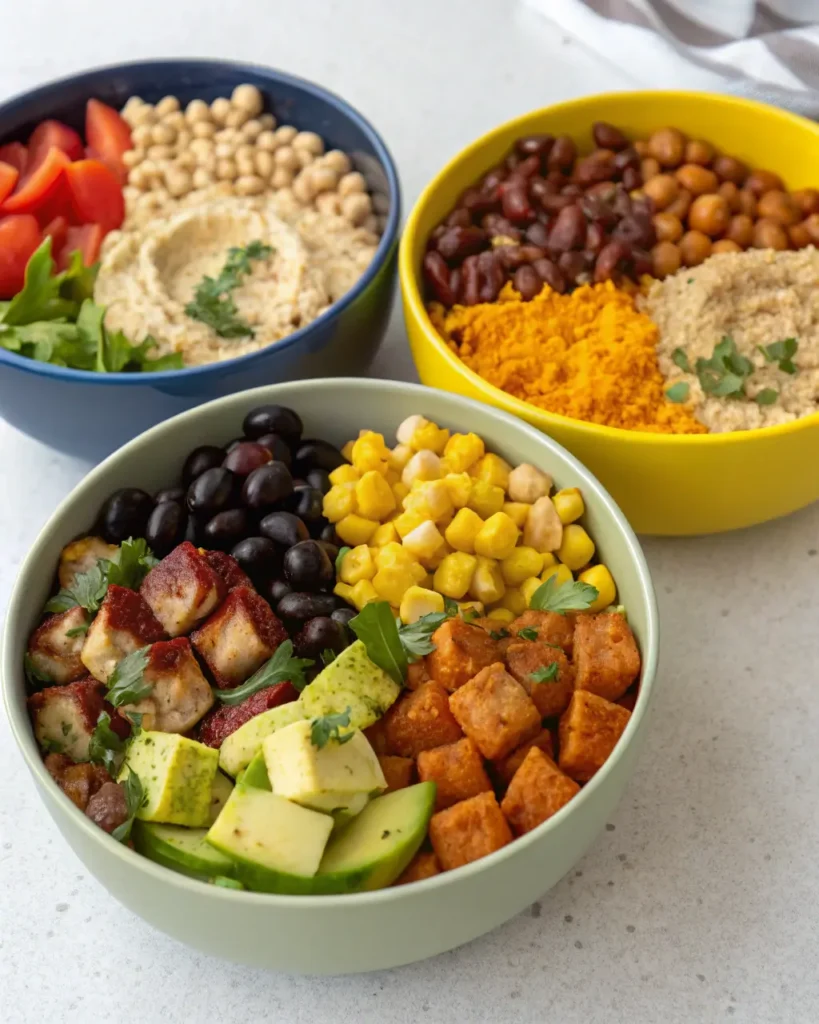
Ready to build your own stunning creation? The beauty of the Colorful Buddha Bowl lies in its infinite customizability. To get your creative juices flowing, here are seven inspiring ideas, ranging from classic veggie combinations to more unique flavor profiles. Use these as starting points and feel free to mix, match, and adapt based on your preferences and what’s available in your kitchen.
Recipe Idea 1: The Ultimate Rainbow Veggie Delight
This bowl is all about maximizing color and fresh flavors. Start with a base of quinoa. Top with sections of shredded purple cabbage, vibrant orange shredded carrots, bright green edamame, sunny yellow bell peppers, and deep red cherry tomatoes. Add baked tofu or chickpeas for protein. Drizzle generously with a light lemon-tahini dressing and sprinkle with black sesame seeds for contrast. This is a quintessential Colorful Buddha Bowl experience.
Recipe Idea 2: Mediterranean Sunshine Bowl with Hummus
Transport yourself to the Mediterranean with this flavorful bowl. Use farro or couscous as the base. Add roasted vegetables like zucchini, eggplant, and red onions. Include Kalamata olives, cucumber slices, and crumbled feta cheese (optional, for non-vegan). A generous dollop of creamy hummus serves as both protein and part of the sauce. Finish with a sprinkle of fresh oregano or parsley and a light lemon vinaigrette.
Recipe Idea 3: Spicy Peanut Tofu Temptation
For those who love a bit of heat and savory peanut flavor, this bowl is a winner. Use brown rice or soba noodles as the base. Top with pan-fried or baked tofu coated in a spicy peanut sauce (peanut butter, soy sauce, lime juice, sriracha, ginger). Add steamed broccoli florets, shredded carrots, sliced red bell peppers, and bean sprouts. Garnish with chopped peanuts, fresh cilantro, and an extra drizzle of peanut sauce.
Recipe Idea 4: Roasted Sweet Potato & Black Bean Fiesta
Embrace Southwestern flavors with this hearty and satisfying bowl. Start with a base of mixed greens or brown rice. Add roasted sweet potato cubes seasoned with chili powder and cumin, black beans, corn salsa (corn, red onion, cilantro, lime juice), and sliced avocado. A creamy chipotle-lime dressing or a simple salsa works perfectly. Top with crushed tortilla chips for crunch.
Recipe Idea 5: Green Goddess Detox Power Bowl
Focus on vibrant greens and detoxifying ingredients. Use a base of kale massaged with lemon juice or cooked quinoa. Top with steamed asparagus, broccoli florets, sliced cucumber, avocado, and green peas or edamame. Add grilled chicken or chickpeas for protein. The star is a creamy Green Goddess dressing made with herbs (parsley, chives, tarragon), yogurt or cashews, lemon juice, and garlic. Sprinkle with pumpkin seeds.
Recipe Idea 6: Savory Teriyaki Salmon Sensation (Pescatarian Option)
For a non-vegetarian twist, this bowl features flaky salmon. Use sushi rice or brown rice as the base. Add a fillet of baked or pan-seared salmon glazed with teriyaki sauce. Complement with steamed bok choy or spinach, pickled ginger, shredded carrots, and sliced radishes. Drizzle with extra teriyaki sauce or a light sesame-ginger vinaigrette. Garnish with toasted sesame seeds and nori strips.
Recipe Idea 7: Quinoa Berry Bliss Breakfast Bowl (A Sweet Twist)
Who says a Colorful Buddha Bowl has to be savory? Try a breakfast version! Use cooked quinoa as the base, perhaps mixed with a little cinnamon and maple syrup. Top with a vibrant array of fresh berries (strawberries, blueberries, raspberries), sliced banana, a dollop of Greek yogurt or coconut yogurt, and a sprinkle of chia seeds and chopped almonds or walnuts. It’s a nutritious and beautiful start to your day.
Streamline Your Meals: Tips for Meal Prepping Your Colorful Buddha Bowl
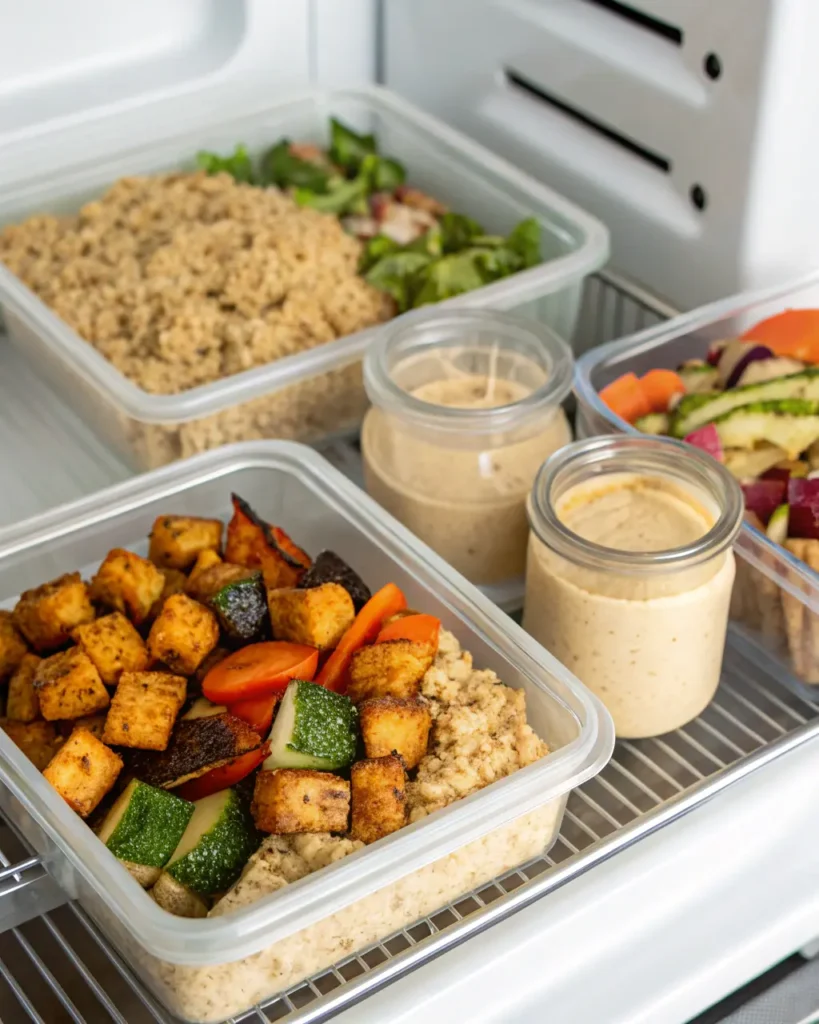
One of the best things about the Colorful Buddha Bowl concept is how well it lends itself to meal prepping. By preparing components in advance, you can assemble a delicious and healthy bowl in minutes, making it perfect for busy weeknights or quick lunches. Efficient meal prep is key to consistently enjoying these vibrant meals.
Smart Strategies: Batch Cooking Components for Quick Assembly
Save time during the week by batch cooking key ingredients over the weekend or whenever you have a spare hour. Cook a large batch of your chosen grain (quinoa, brown rice, farro). Roast a big tray of mixed vegetables like sweet potatoes, broccoli, cauliflower, and bell peppers. Prepare your protein source – bake or pan-fry tofu, cook a batch of lentils, or hard-boil some eggs. Wash and chop raw veggies like carrots, cucumbers, and radishes. Having these components ready in the fridge transforms bowl assembly from a chore into a quick mix-and-match process.
Storage Savvy: Keeping Your Ingredients Fresh and Ready
Proper storage is essential to ensure your prepped ingredients stay fresh and appealing throughout the week. Store cooked grains, proteins, and roasted vegetables in separate airtight containers in the refrigerator. Keep chopped raw vegetables in containers as well, perhaps with a damp paper towel for greens to maintain crispness. Store dressings in airtight jars or bottles. When it’s time to eat, simply combine your desired components in a bowl, add your dressing, and enjoy your pre-prepped Colorful Buddha Bowl. This approach minimizes daily cooking time while maximizing healthy eating opportunities.
Elevate Your Bowl Game: Advanced Tips, Tricks, and Customization
Once you’ve mastered the basics of building a Colorful Buddha Bowl, there are countless ways to elevate your creations from simple meals to culinary masterpieces. Experimenting with dressings, textures, and global flavors can keep your bowls exciting and endlessly varied. Taking your bowl game to the next level involves a bit of creativity and attention to detail.
Dressing Mastery: Delicious Homemade Sauces vs. Healthy Store-Bought Options
A great dressing can make or break your bowl. While convenient store-bought options exist, making your own dressings allows for complete control over ingredients, flavor, and healthfulness. Experiment with bases like tahini, cashew cream, yogurt, or avocado. Infuse flavors with herbs, spices, citrus juices, ginger, garlic, or miso paste.
Consider a classic lemon-tahini, a zesty cilantro-lime vinaigrette, a creamy avocado-herb blend, or a rich almond-ginger sauce. If opting for store-bought, carefully read labels to avoid excessive sugar, sodium, and unhealthy fats. Look for options with simple, recognizable ingredients. Mastering a few go-to homemade dressings significantly enhances your Colorful Buddha Bowl repertoire.
Beyond the Basics: Playing with Textures, Temperatures, and Global Flavors
Don’t be afraid to push the boundaries beyond the standard formula. Introduce diverse textures: add something crunchy like toasted nuts, seeds, crispy chickpeas, or baked wonton strips; something creamy like avocado or hummus; something chewy like roasted mushrooms or sun-dried tomatoes. Play with temperatures by combining warm components (roasted veggies, grains) with cool ones (raw greens, cucumber).
Explore global flavor profiles: create a Thai-inspired bowl with peanut sauce, mango, and cilantro; an Indian-inspired bowl with curried lentils, spiced cauliflower, and raita; or a Japanese-inspired bowl with edamame, pickled ginger, seaweed, and miso dressing. The possibilities for your Colorful Buddha Bowl are truly limitless when you start experimenting.
Print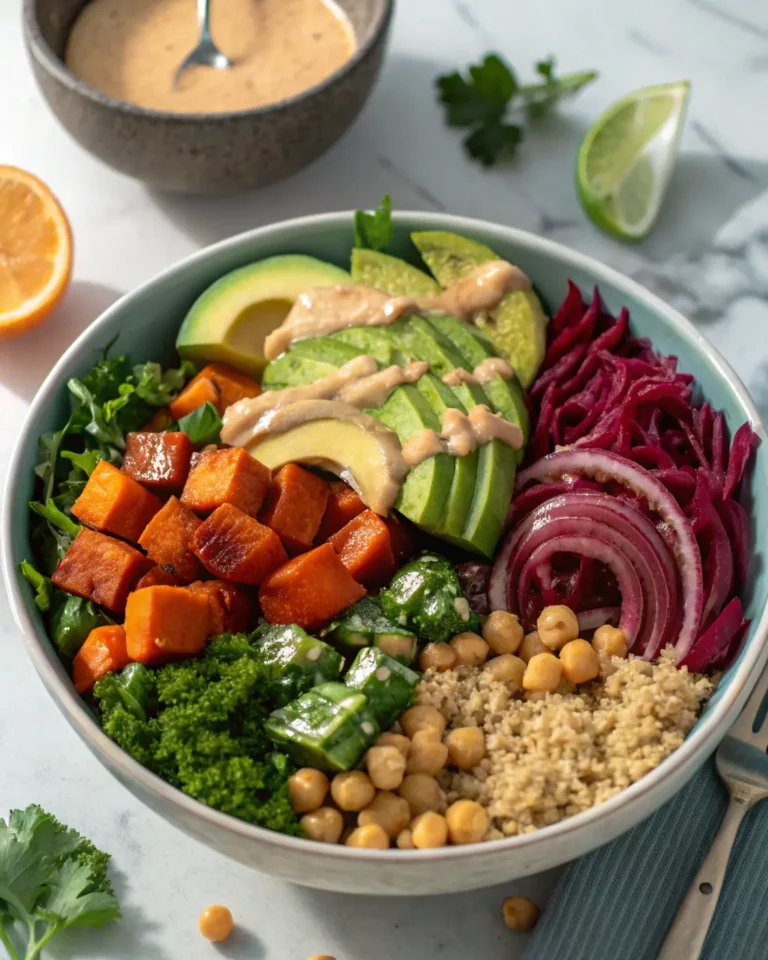
Colorful Buddha Bowl (Vegan & Gluten-Free)
This vibrant and wholesome Buddha Bowl is loaded with rainbow veggies, hearty grains, and plant-based protein, topped with a creamy tahini dressing. Perfect for meal prep or a healthy lunch, it’s vegan, gluten-free, and totally customizable!
- Total Time: 30 minutes
- Yield: 2 servings 1x
Ingredients
For the Bowl:
- 1 cup cooked quinoa (or brown rice)
- 1/2 cup canned chickpeas, drained and rinsed
- 1 cup shredded purple cabbage
- 1/2 avocado, sliced
- 1/2 cup grated carrots
- 1/2 cup sliced cucumber
- 1/2 cup cherry tomatoes, halved
- 1/4 cup edamame (optional)
- Handful of baby spinach or kale
- Sesame seeds (for garnish)
For the Dressing:
- 2 tbsp tahini
- 1 tbsp lemon juice
- 1 tsp maple syrup
- 1 clove garlic, minced
- 2–3 tbsp warm water (to thin)
- Salt to taste
Instructions
- Prepare the grain: Cook quinoa (or brown rice) according to package instructions. Let it cool slightly.
- Roast or sauté chickpeas (optional): For extra flavor, toss chickpeas in a bit of olive oil, paprika, and salt, then roast at 400°F (200°C) for 15–20 minutes.
- Make the dressing: Whisk together tahini, lemon juice, maple syrup, garlic, and salt. Add warm water a little at a time until desired consistency.
- Assemble the bowl: Start with a base of quinoa. Arrange veggies, chickpeas, and avocado in colorful sections.
- Top and serve: Drizzle with tahini dressing, sprinkle sesame seeds, and enjoy!
Notes
- Swap quinoa for farro, couscous, or rice.
- For extra protein, add baked tofu or tempeh.
- Store leftovers in separate containers (especially the dressing) for up to 3 days.
- Use whatever veggies you have on hand — this bowl is all about flexibility!
- Prep Time: 15 minutes
- Cook Time: 15 minutes
- Category: Lunch
- Method: Raw + Assembled + Optional Roasting
- Cuisine: Fusion
- Diet: Vegan
Nutrition
- Serving Size: 1 bowl
- Calories: ~450 kcal
- Sugar: 6g
- Sodium: 320mg
- Fat: 20g
- Saturated Fat: 3g
- Unsaturated Fat: 16g
- Trans Fat: 0g
- Carbohydrates: 52g
- Fiber: 10g
- Protein: 14g
- Cholesterol: 0mg
Keywords: vegan buddha bowl, colorful bowl, rainbow bowl, plant-based lunch, gluten-free bowl, vegan meal prep, tahini dressing, healthy vegan recipe, quinoa bowl
FAQ
What exactly is in a Colorful Buddha Bowl?
A Colorful Buddha Bowl typically contains a mix of whole grains or greens, plant-based proteins (like tofu, beans, or lentils), a variety of fresh and cooked vegetables, a flavorful dressing, and toppings like seeds, nuts, or herbs. It’s a visually vibrant and nutritionally balanced one-bowl meal.
Are Buddha Bowls always vegan or vegetarian?
Not necessarily. While most Buddha Bowls are plant-based, you can easily adapt them to include animal proteins like grilled chicken, boiled eggs, or fish if desired. The beauty of the bowl lies in its flexibility and customization.
Are Buddha Bowls good for weight loss?
Yes, they can be. When made with nutrient-dense, fiber-rich ingredients and portioned mindfully, Buddha Bowls can support weight loss by promoting satiety and reducing cravings. The key is to avoid calorie-heavy dressings and toppings.
Can I meal prep Buddha Bowls for the week?
Absolutely! Buddha Bowls are great for meal prep. You can prepare the components in advance (grains, proteins, roasted veggies) and store them separately. Assemble your bowl fresh each day to maintain texture and flavor.
What are some good dressings for Buddha Bowls?
Popular dressing options include lemon tahini, peanut sauce, creamy avocado, balsamic vinaigrette, and miso-ginger dressing. Choose dressings with healthy fats and natural ingredients for the best nutrition.
What’s the difference between a Buddha Bowl and a poke bowl?
A poke bowl is Hawaiian in origin and usually features raw fish like tuna or salmon with rice and Asian-inspired toppings. A Buddha Bowl is generally vegetarian or vegan, focusing on plant-based proteins, colorful vegetables, and whole grains.
Why is it called a Buddha Bowl?
The origin of the term is debated. Some say it refers to the round, full shape resembling a Buddha’s belly, symbolizing abundance. Others connect it to the tradition of Buddhist monks collecting small portions of food in a single bowl. While commonly used, it’s good to be mindful of the name’s cultural context.
Can I serve a warm Buddha Bowl?
Definitely! While many Buddha Bowls include raw ingredients, they can also be served warm, especially with roasted veggies, sautéed greens, or warm grains. The temperature can vary based on your preferences and the season.

